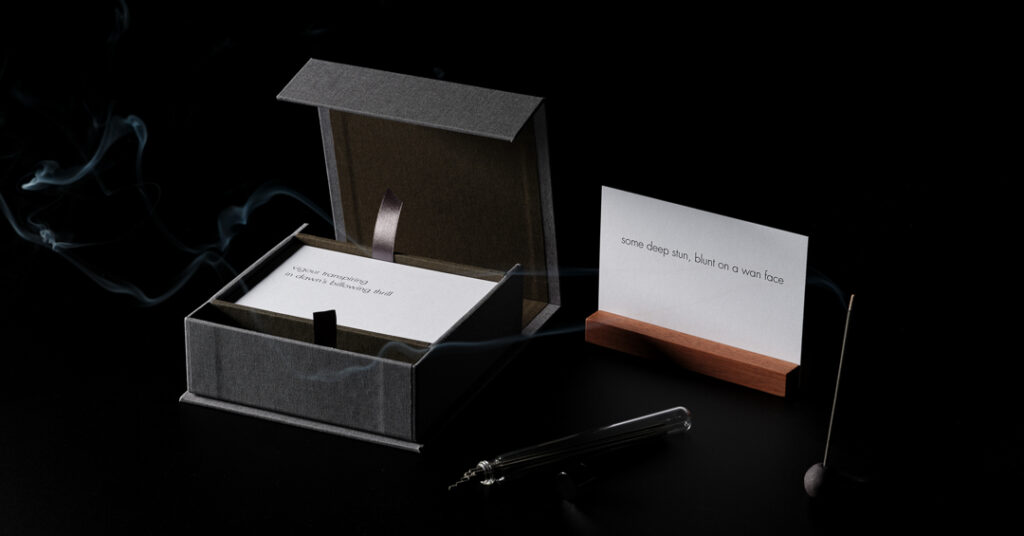Kathryn Bird describes the incense ritual that provides a shared emotional thread through the process of mourning her husband.
Co-writing an obituary for my very lovely husband Ross Gibson in a swirl of grief, the quality that rose above all as definitional of him was the stillness and focus of his listening. He even had a classic listening gesture: thumb resting under his chin, long index finger resting on his cheek. A great many people found their words taking shape and their ideas meshing into clarity while under the calm gaze of RG in listening mode. All the senses were stilled and focused. It struck us as extremely apt, then, when we discovered some years ago that there’s a delightful sensory sideways shift in the choice of verb for appreciating incense in Japan. One does not smell incense. One listens to incense. Indeed it is an apparatus for listening through fragrance, a way of focusing the senses. Shoyeido, one of the oldest and most revered producers of incense – the maker of what has become RG’s signature incense – describes it this way:
“We use the expression “listening to incense” to describe the delicate process of enjoying the subtle fragrance of a tiny piece of aromatic wood.
As we embrace the bowl in our palms, the gentle scent beckons us to use all of our senses–a process also known as “Mon-koh.”
The discovery of Ross’s signature incense – Hakkuan, by Shoyeido – was a long process of listening and sensing over many years of regular trips to Kyoto. A waft of fragrance in a mountain temple would lead Ross to an investigation of the maker of the incense, and, if it could not be purchased from the temple, a perambulation to one of the incense houses to see if it could be fossicked up from the many subtle variants. Ross would write the names of the temples on the side of the incense boxes in his beautiful script and, back home, we could wander from temple to temple again through scent.
Primarily, though, Ross would use incense as a passage into a writing mode. Although we lived always in an open-plan warehouse, the lighting of the incense was a gentle marker that Ross was heading into a mode requiring focus. Incense is, after all, a temporal element in a space. The length of time that it takes for a standard stick of high-quality Japanese incense to burn to ash is perhaps the closest that we will come to an increment of meditation. Through the process of mourning, I have sat and watched many sticks of Hakkuan (White Cloud) burn through their entire length, often in the silent company of other mourners. It’s a perfect length of contemplative time. And now it’s become a device for summoning him anywhere. I carry it with me in a vial and burn it and he’s there in the fragrance that makes calligraphic shapes in the air.

Documentation of 14 breaths. Photographer: Peter Whyte. Project Credit: Ross Gibson, Kathryn Bird & A Published Event
Before Ross’s death, we crafted mourning rituals around the White Cloud incense so that this summoning could be possible for others as well. We held a week-long retreat at the house of a friend in Palm Beach, with different people cycling in and out and staying and eating and walking at different times.
We would watch the sunset collectively in silence, in the gentle swirling of the smoke. We would place our sticks in a brazier and depart back down the hill.
At dusk each day, the day’s participants would undertake a simple ritual that I devised in collaboration with the artist Barbara Campbell. Gathering at the base of a steep tropical garden, each person was handed a stick of White Cloud. One by one, the sticks would be lit and the person would process up the garden to a meditation platform overlooking the sea, trailing a waft of incense behind them. As we progressively reached the top, the smoke of all our individual sticks would merge and meld. We would watch the sunset collectively in silence, in the gentle swirling of the smoke. We would place our sticks in a brazier and depart back down the hill. On leaving the retreat, each visitor would be handed a glass vial that contained 5 sticks of White Cloud and a poem written by Ross and hand-typed by Barbara Campbell on Japanese paper. It was ceremonially presented in the Japanese way, from my two hands to your two hands, accompanied by the simple verbal instruction: when you hear that Ross has died, burn this and think of him. On the morning that Ross died, I sent out a simple message: it’s time to light the incense.
Our final collaborative project was also the most beautiful collaboration of our lives, and it furthered this foregrounding of White Cloud incense as a mourning instrument. Our dear friends and collaborators Justy Phillips and Margaret Woodward, who together make up the Hobart-based enterprise A Published Event, asked if they could facilitate the making of a last work, a dream project. The work we four made together was 14 breaths, a mourning kit, akin to a tea ceremony kit. Made in an edition of 65, one for every year of Ross’s life, 14 breaths contains a vial of 14 sticks of White Cloud incense, 14 cards of Ross’s poetry (randomly selected from 28 possible cards so that no two experiences are the same), a custom made incense burner, and a stand for the cards. Ross was a quiet and private fellow, and this structure for grieving and private meditation through incense recalls through sense-memory the communal incense ritual of the Iiving wake.
Follow @prettyshake
See also

Libraries of stone and wood, A Published Event
Monkō (聞香): The Japanese way of listening to incense, Sachiko Tamashige




Comments
Thank you for sharing this.
What a beautiful way to live, what a beautiful way to grieve.
My thoughts are with you.